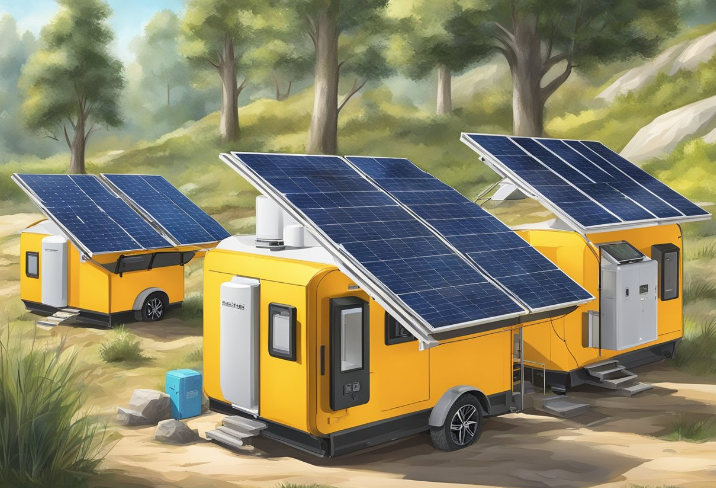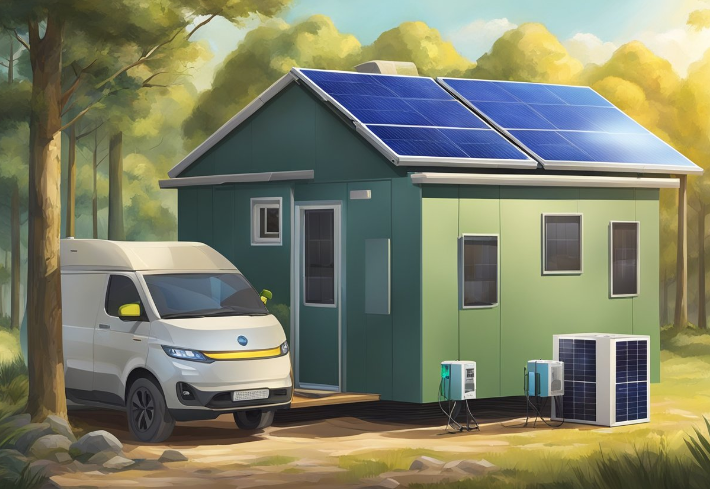Off Grid Living with Solar Powered Portable Power Stations: Harnessing the Power
Living off the grid is an increasingly popular lifestyle choice for those who want to reduce their carbon footprint and become more self-sufficient. However, living off the grid comes with its own set of challenges, one of which is generating enough power to meet your daily needs. Fortunately, harnessing the power for off grid living with solar-powered portable power stations is a great solution for those who want to live off the grid without sacrificing modern conveniences.

Solar-powered portable power stations are essentially small, portable generators that use solar panels to generate electricity. They are a great option for those who want to live off the grid because they are lightweight. They are also easy to transport, and can be used in remote locations. Additionally, they are a sustainable and environmentally friendly alternative to traditional generators, which can emit harmful pollutants and rely on fossil fuels.
If you're considering off-grid living, solar-powered portable power stations are an excellent option for generating electricity. Beginning below, we'll explore the benefits of off-grid living, the advantages of solar-powered portable power stations. Also included is how to implement off-grid living with solar power. We'll also answer some frequently asked questions about living off the grid and using solar power.
Key Takeaways
- Solar-powered portable power stations are a great solution for those who want to live off the grid without sacrificing modern conveniences.
- They are lightweight, easy to transport, and can be used in remote locations, making them a great option for off-grid living.
- Implementing off-grid living with solar power is a sustainable and environmentally friendly alternative to traditional generators.
Understanding Off-Grid Living

Living off-grid means that you are not connected to the public utility grid and you generate your own electricity. Off-grid living is becoming increasingly popular, especially with the rise of portable solar power stations. The concept and importance of off-grid living, as well as its advantages and challenges is discussed below.
Concept and Importance
Off-grid living is a lifestyle choice that involves generating your own electricity, collecting your own water, and managing your own waste. This lifestyle is often associated with living in remote locations, but it can also be adopted in urban areas. The concept of off-grid living is based on the principles of self-sufficiency and sustainability.
Off-grid living is important because it allows you to reduce your carbon footprint and decrease your reliance on fossil fuels. It also provides you with greater independence and freedom, as you are not tied to the public utility grid. Off-grid living can also be a way to save money in the long run, as you are not paying for electricity, water, or waste management services.
Advantages and Challenges
Off-grid living has several advantages, including:
- Energy independence: You are not reliant on the public utility grid for your electricity needs.
- Environmental sustainability: You are reducing your carbon footprint by generating your own electricity from renewable sources.
- Cost savings: You are not paying for electricity, water, or waste management services.
However, off-grid living also has its challenges, including:
- Upfront costs: Setting up an off-grid system can be expensive, especially if you are installing solar panels, batteries, and other equipment.
- Maintenance: Off-grid systems require regular maintenance to ensure they are functioning properly.
- Limited resources: Off-grid living requires you to be mindful of your energy and water usage, as resources may be limited.
Overall, off-grid living can be a rewarding and sustainable lifestyle choice. With the rise of portable solar power stations, it is becoming more accessible and affordable for people who want to live off-grid.
Solar-Powered Portable Power Stations
If you're looking to live off the grid or simply want a reliable backup power source, a solar-powered portable power station is an excellent investment. It is a great place to start living utility-free. These devices can keep your batteries full during power outages and off-grid campouts. In this section, we'll cover the fundamentals of solar power and the types and features of solar-powered portable power stations.
Fundamentals of Solar Power
Solar power is the conversion of energy from sunlight into electricity. This process is accomplished using solar panels, which are made up of photovoltaic cells that convert sunlight into direct current (DC) electricity. The DC electricity is then converted into alternating current (AC) electricity using an inverter, which can be used to power your home or charge your portable power station.
The amount of energy produced by solar panels depends on several factors, including the amount of sunlight available, the angle and orientation of the panels, and the efficiency of the solar cells. To maximize the energy produced by your solar panels, it's important to ensure that they are installed in a location that receives plenty of sunlight and that they are angled and oriented correctly.
Types and Features
When it comes to solar-powered portable power stations, there are several types and features to consider. Here are some of the most important:
- Capacity: The capacity of a portable power station is measured in watt-hours (Wh) and determines how much energy it can store. Make sure to choose a capacity that suits your needs.
- Output: Portable power stations come with various outputs, including AC outlets, USB ports, and DC ports. Make sure to choose a model that has the outputs you need.
- Charging: Portable power stations can be charged using solar panels, AC outlets, or car adapters. Make sure to choose a model that can be charged using the method that is most convenient for you.
- Expandability: Some portable power stations can be expanded by adding additional batteries or solar panels. If you think you may need more capacity in the future, make sure to choose a model that is expandable.
- Weight and Size: Portable power stations come in various sizes and weights. Make sure to choose a model that is portable enough for your needs.
Overall, solar-powered portable power stations are an excellent investment for anyone looking to live off the grid or simply have a reliable backup power source. By considering the fundamentals of solar power and the types and features of portable power stations, you can choose the model that is right for you.
Implementing Off-Grid Living with Solar Power
If you're considering off-grid living with solar power, you're on the right track to energy independence. Solar power is an excellent way to generate electricity for your home without relying on public utilities. Here's what you need to know to get started.
Step-by-Step Guide
- Determine your energy needs: Calculate how much energy your household consumes on a daily basis. This information will help you determine the size of the solar-powered portable power station you need.
- Choose the right solar-powered portable power station: Look for a portable power station that can provide enough power to meet your household's energy needs. Consider factors such as battery capacity, output power, and input power.
- Install solar panels: Solar panels are the primary source of energy for your portable power station. Install enough solar panels to generate sufficient energy to charge your portable power station.
- Connect your portable power station to the solar panels: Connect your portable power station to the solar panels using the appropriate cables and connectors.
- Charge your portable power station: Allow your portable power station to charge fully before using it.
- Use your portable power station: Once your portable power station is charged, you can use it to power your household appliances and devices.
Maintenance and Safety Tips
- Regularly clean your solar panels to ensure they are generating maximum power.
- Store your portable power station in a cool, dry place.
- Do not expose your portable power station to extreme temperatures or direct sunlight.
- Use caution when connecting and disconnecting your portable power station from the solar panels.
- Do not attempt to repair or modify your portable power station unless you are qualified to do so.
- Always follow the manufacturer's instructions for use and maintenance of your portable power station.
By following these steps and safety tips, you can successfully implement off-grid living with solar power. Enjoy the benefits of energy independence and reduce your carbon footprint.
Frequently Asked Questions About Off Grid Living With Solar Powered Portable Power Stations
How much solar power is required for off-grid living?
The amount of solar power required for off-grid living depends on your energy needs and usage. Typically, a home requires anywhere from 5 to 20 kilowatts of solar power to meet its energy needs. However, this can vary depending on the size of your home, the number of appliances you use, and the amount of sunlight your area receives.
Can a portable solar power station power a house?
While a portable solar power station can provide power to small appliances and devices, it is not designed to power an entire house. For off-grid living, a larger solar panel system with battery storage is required to meet the energy demands of a home.
Are portable solar power stations a worthwhile investment?
Portable solar power stations can be a worthwhile investment for those who enjoy camping or need a backup power source for emergencies. They are also useful for powering small appliances and devices in off-grid locations. However, they may not be cost-effective for those looking to power an entire home.
What are the benefits of off-grid living with solar power?
Off-grid living with solar power provides several benefits, including reduced energy costs, increased energy independence, and reduced carbon footprint. It also allows you to live in remote locations without access to traditional power sources.
What are the best DIY portable power station options for camping?
There are several DIY portable power station options for camping, including building your own power bank using lithium-ion batteries and a charge controller. Other options include using a solar panel and a battery box or purchasing a pre-built portable power station.
How does a lithium portable power station compare to other types?
Lithium portable power stations are lightweight, compact, and have a longer lifespan than other types of portable power stations. They also have a higher energy density, meaning they can store more energy in a smaller space. However, they are typically more expensive than other types of portable power stations.
